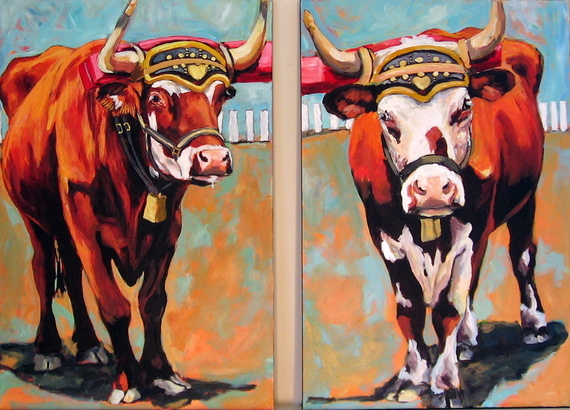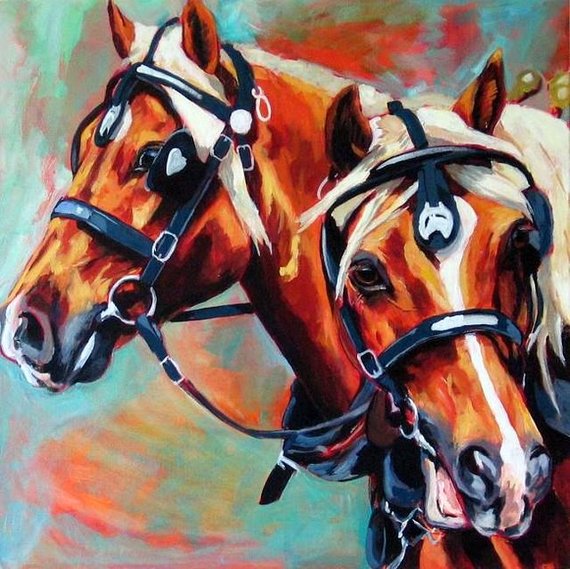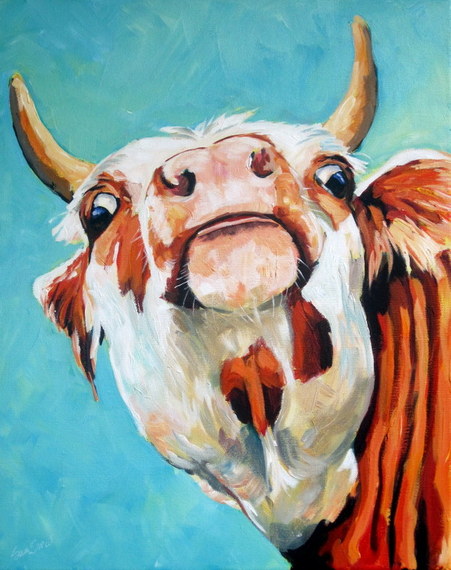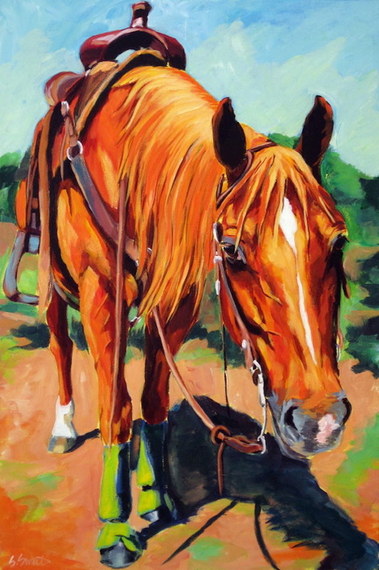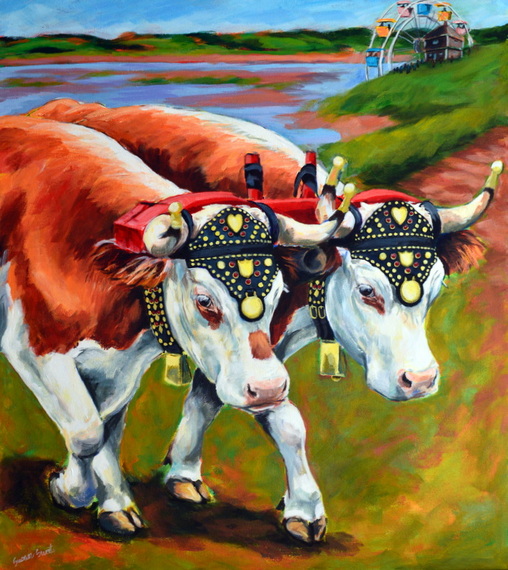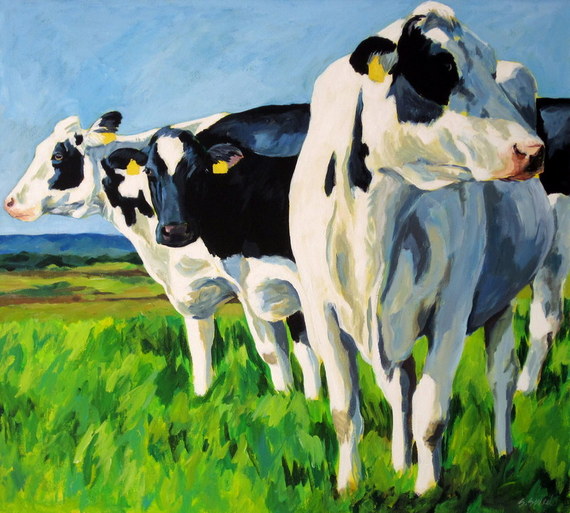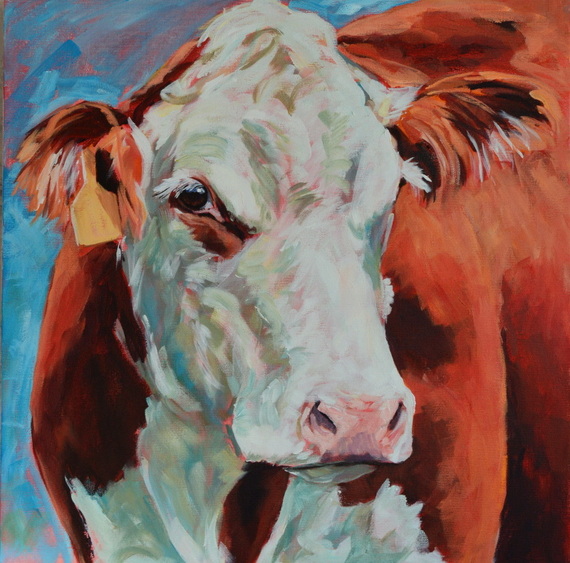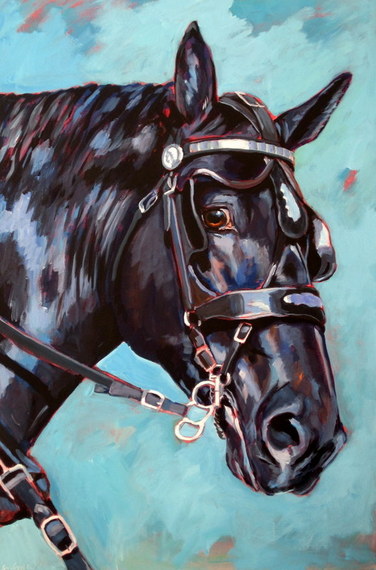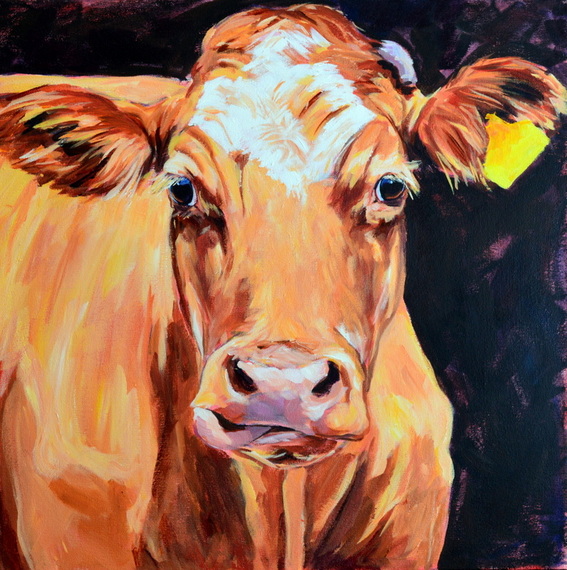Perhaps it was inevitable that I would eventually end up interviewing family - as I am not the lone artist in our bloodline. So, as a photography and arts blogger, it made sense to corner my aunt, painter Susan Sweet, and try to squeeze a little more than an artist statement out of her. Here is my attempt.
Michael Ernest Sweet: Why paint? I always ask this of painters and they usually don't like the question, but too bad, I want to know?
Susan N. Sweet: I paint because I can't stop. I will often do almost anything to avoid getting started, but then once the paint hits my brush, it is what I want to do and where I want to be. It is the form of art making I am most interested in. I look at everything and imagine how I might paint what I see. The more immersed I am in a painting, the more the world around me breaks down into colours and planes of light, and how I might describe them.
Michael: My grandmother (your mother) was a creative person in many ways, having operated a business, Lady Martock Fashions in Sleepwear, for a couple of decades after retiring from teaching. She both designed and made these often elaborate, almost Victorian, nightgowns. It wasn't painting or photography, but she certainly was designing. Do you think she had any influence on your life as an artist?
Susan: My mother, Muriel, was the only art teacher I ever had in my first thirteen years of school. She taught art in the basement of Windsor Elementary, and was my teacher in Grade five. I think she was a bit hard on me as I was her child and she never wanted to appear biased. She was supportive of everything her children pursued and not that concerned with how much financial success we achieved, as long as we were happy and doing okay. I think that was her influence on my career in art making - just do what you want and try to be happy. Her true impact on my life, all our lives, as you know, is very hard to articulate.
Michael: Your maternal grandfather was also an artist. In fact, he was a wood carver of some note that depicted domesticated animals. Could some of your animal art be genetic, or is it simply a product of growing up in the Nova Scotia countryside?
Susan: Probably a bit of both. I did not know either of my grandfathers, both died long before any of us were born, but I was very familiar with his wood carvings, a very primitive style of Nova Scotia folk art. I like the idea of continuing the subject matter that was such a part of all of our lives.
Michael: Familiar indeed! One advantage to interviewing a relative is that I know some of the stories. For example, many of those wood carvings of your grandfather's encountered some damage. Could you tell us about that and the ensuing irony?
Susan: That story featured prominently in my 2008 solo show "Broken Horses, Spotted Cattle". When I was five and my brother, your dad, was four, our mother had gone back to teaching and left us with the housekeeper. I was not happy about that. So, I enlisted the help of my brother and we quietly went upstairs to the flat my grandmother lived in and got into her cabinet full of the wooden carvings and broke the legs and tails off of as many as we could. My mother was furious and, of course, wanted to punish us, but my grandmother, also a teacher, said no, they are just little children and they don't know what they've done. Of course, I did know what I intended to do, and that was hurt my mother for leaving us to return to work, but what I didn't know was the hurt I had caused my grandmother and how she understood my feelings. I still have many of the broken carvings. A few years after the incident we did attempt to repair them, but of course it was too late.
Michael: All of your animal paintings are exquisite. Many people tell me that you are able to capture the personality of their pets. When you paint horses I, personally, find something really magical about them. Do you think your relationship with real horses growing up helps you in your artistic work? Are you able to talk, or whisper, to horses?
Susan: No, I am not a horse "whisperer". I do talk to horses, all of us horse people do that. For many years I breathed and lived horses. I do think my personal relationships with horses have helped me when drawing and painting them. Having grown up with horses and been around them daily for a very long time, one understands how they are built and how they move. There is a long history of equine art throughout the centuries, humankind has had an important relationship with horses that enabled our ancestors to travel, hunt, work the land, etc.
Michael: Indeed, we see beautiful examples of equine art from prehistoric times in the caves at Chauvet, for example. So, yes, we do seem to have been drawing them from the very beginning. You were recently commissioned to paint the official 250th anniversary commemorative painting for the Hants County Exhibition. My grandfather (your father, Ernest Sweet) was President of the exhibition for many years, including the 200th anniversary, how do you think he would feel about this if he were alive?
Susan: Oh, I think he would be delighted and quite pleased that I was approached to paint such a special commission. He loved Exhibition week. This fair is the oldest fair in North America and moved to its present location in 1951. My dad would have participated in livestock competitions beginning in the late 1930s, when the fair was held at the Fort Edward Hill in Windsor, Nova Scotia.
Michael: Grandad was an avid supporter of rural life and agriculture - having held other positions at The Atlantic Winter Fair and the NS Agriculture Association, for example. He also farmed (in some way) most every day for likely close to 70 years. What impact does this heritage have on your work?
Susan: I do find most of my subject matter comes from rural life. Horses, cattle, and the land, all figure prominently in what I paint. I am always interested in how we treat our domesticated animals, both the ones we eat and our companion animals. I feel very fortunate to live in a rural area where I am close to where our food is grown and where we are concerned with what happens on the land. Urban areas are so exotic to me! My father was an avid horseman. He worked the woods and the fields as a young man with horses, and his love of these things influenced me greatly. I also saw what happened to so many people as the family farms slowly disappeared. As my father slowly sold his own farming assets over the years, I became involved with horses and competing at the same fairs where he had shown his own cattle years before.
Michael: During your BFA, at the Nova Scotia College of Art and Design, you worked in painting and photography as well as printmaking. The photography stuck with you for some time afterward, and of course you still paint, but what about the printmaking?
Susan: Printmaking became just too hard after I left the open studio environment of university. I found both intaglio and lithography a fascinating form of art making, but technically overwhelming, and I don't feel my work was all that memorable from my university years. I do still find myself drawn to prints, especially intaglio. Nova Scotia has some fabulous print makers thanks to the department run by Ed Porter and Bob Rogers at NSCAD University for many years.
Michael: I often marvel about the lifespans of so many artists (and photographers too) it seems (from my casual survey) that so many live such long lives. I think about Alex Colville, whom I knew, and how he worked into his nineties. Do you think there is something therapeutic or particularly healthy about a life as an artist?
Susan: Oh my goodness no! I do know of many older artists, in fact the gallery where I work summers represents a 92 year old who is still painting, but I am sure many other professions can offer up such individuals too. I often think there are so many toxic materials artists use in their work and that we are putting ourselves in danger! I don't have a sense of calm when I paint. Painting for me is always a struggle and a challenge when it is being pulled from my heart. I find no relaxation in painting. I am focused though, and I can paint in public with no problem. It doesn't bring me contentment though, not really. I am happy when I am painting, but it is the hardest thing in the world.
Michael: For a while you went in a direction that was a bit more commercial with your Animal Art business (earrings, brooches, ornaments, even small drawings of pets) but more recently you seem to have returned to fine art. What inspired this shift away from business woman, if you will, back to les beaux-arts?
Susan: I needed to say something in my work that could not be achieved through a commercial practice and taking a risk to paint what matters to me seems to be working. I also worked very small for many years and my body was rebelling against the ten hours of sitting every day. I still produce commercial portraits of animals for clients, but I follow my heart and luckily people do respond to my current body of work.
Michael: Often many artists reach a point in their career where teaching becomes an option - that is, schools seek you out. This can also be an important income supplement to support personal projects. Have you ever thought about teaching part-time, perhaps a class at your old alma mater?
Susan: I would be the worst teacher ever. I have conducted an occasional workshop, and those are fun. Many people in our family are teachers, and really good ones - I am not one of them.
Michael: Not only living in a more remote rural area, but also working in a home studio can become quite isolating, I would imagine. How have you dealt with this, perhaps more negative, aspect of the creative life?
Susan: It does mean that one must work very hard to be noticed. We've become reliant on the internet to communicate so much. I like living and working in a rural area, and even my rare excursions into civilization only involve small towns and cities. I think we sometimes miss the positive aspects of peer criticism working so isolated, but the area where I live has many other artists working in various media. I can also have my studio right in my home.
Michael: In the years when you and I both lived at the family home in Martock, we often fought like brother and sister, or cats and dogs. I think this has a lot to do with my obsessive compulsive tendencies and your "artistic" messiness, If I can express it this way. Oddly enough, we both ended up as artists, and would likely live under the same roof more easily now. Or would we?
Susan: Oh, we are much more mature now. Or at least I am! We would easily get along. I am still extremely messy though, be warned, that hasn't changed. Come here anytime, there is lots of room to work!
Michael: I'd love to, believe me. New York City is wonderful, but it's a very BIG kind of wonderful and sometimes I long for the quiet of the countryside. To finish up, tell me, who has influenced your work as an artist?
Susan: I admire the work of Rosa Bonheur. She could really paint a horse! Joe Fafard of Saskatchewan is fabulous. Mary Pratt of Newfoundland. Edward Hopper, David Hockney, Tom Thompson (and any of the group of seven) and Emily Carr. There are so many I admire, but in the end, I find I can only paint the way I do.
Susan Sweet is a painter who has spent most of her life in rural Hants County, Nova Scotia. She graduated in 1990 from the Nova Scotia College of Art and Design University with a Bachelor of Fine Arts in Fine Art, with a minor in Art History. Her work is held in many public and private collections, including the Nova Scotia Art Bank. Follow or contact via Facebook or her website.

